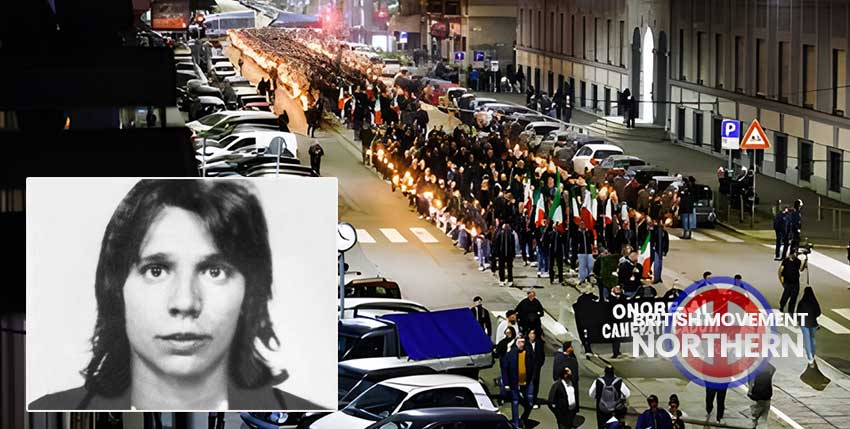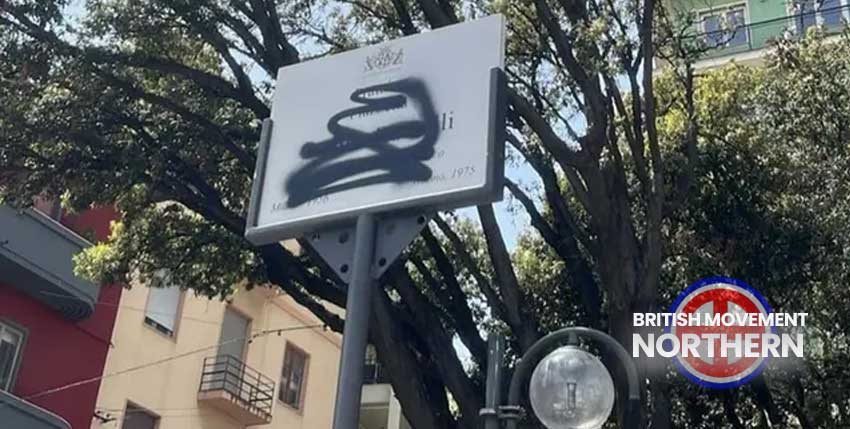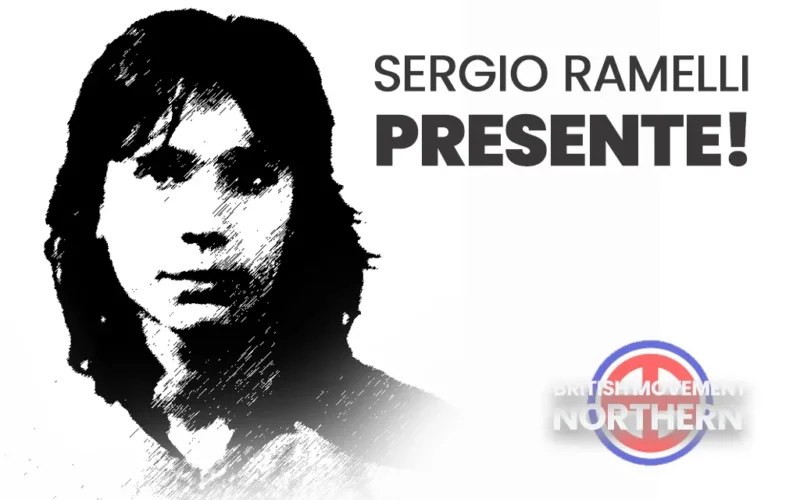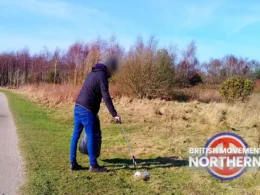On 29 April 1975, the 19-year-old Youth Front activist Sergio Ramelli was murdered in Milan, amidst general indifference. Similar to the lingering death of the NS martyr Horst Wessel, Sergio was attacked in Milan on 13 March 1975 but did not succumb to his injuries until 29 April. This kind and gentle young man had been sentenced to death by the enemies of Italy for writing a simple essay.
Many of you reading this post will have seen the recent images and videos of 1,500 racial Nationalist militants holding a disciplined procession through Milan in remembrance of Sergio Ramelli on the 49th anniversary of his martyrdom. After a respectful silence for Sergio, the massed ranks gave the (now legal) Roman salute and shouted “presente” three times as one of their number yelled “For all fallen comrades!”. But who was Sergio Ramelli?

In this post we will take a closer look at the background to the attack and at Segio. The following abridged article was published in the Italian daily newspaper, the Corriere della Sera (Evening Courier). This author is Walter Veltroni and it was first published on 16 February 2020. We reproduce it here with thanks. Translation by Google.
Today I want to talk about Sergio Ramelli, a boy with long hair who was attacked in Milan on the morning of March 13, 1975, with a wrench and died on April 29.
Sergio doesn’t stand out “from all the other young people” but he has right-wing ideas and doesn’t hide them. He is not himself, says those who knew him, a fanatic. He recently joined the Youth Front. But he ended up in a school where his ideas are not tolerated.
It all started with a class assignment. The teacher asks the students to describe an episode that made an impression on them. And Sergio writes an essay on the first assassination of the Red Brigades, the one carried out in Padua in 1974, in which terrorists entered an MSI headquarters and coldly killed Graziano Giralucci and Giuseppe Mazzola. That theme was the beginning of his end.
His companions found out about it and the members of the Avanguardia Operaia political collective pinned the sheets of foolscap paper to the wall, underlining the sentences and commenting on it with the writing: “Here is the theme of a fascist”.
Thus begins Sergio’s ordeal at his school. I leave the story of the various moments to Luca Telese who, with his ‘Black Hearts’, took steps to integrate the memory of those horrendous years. “One morning in January 1975, the kids from the Molinari extra-parliamentary collective entered Sergio’s class. They interrupt the lesson, silence the professor’s feeble resistance, take Ramelli from his desk and drag him out. Nobody dares to stop them. In the corridor a summary trial begins: spitting in the face, insults: “fascist, shame on you!”. Then, when they let him go, a threat: “We’ve just started with you, Ramelli…””
It is the morning of January 13, 1975, Sergio is leaving school, with a backpack of books on his shoulder. All it takes is a signal which is immediately joined by a group of boys, many of whom, older than him, don’t even attend his school. Ten years later the witnesses of that day reconstructed what happened before the magistrates, but no one helped the boy. Sergio is stopped, pushed, forced to hold a brush.
He is – we read in the order for trial – “surrounded in the street by around eighty students and forced to erase with white paint fascist writings that appeared on the wall of the Institute …”. His mother Anita Ramelli says: “He came home all dirty, but he only said to me: “There were some writings and they wanted me to erase them”. He didn’t want to alarm us, make us worried…”
The most dramatic day, during the long persecution that prepared the crime, was February 3, 1975. After many discussions, father and mother Ramelli decided to force their son to abandon Molinari. Sergio is reluctantly forced to accept, and that morning he enters school accompanied by his father to complete the necessary bureaucratic procedures.
Unfortunately they are waiting for them: in the school corridor father and son are attacked, beaten and forced to pass between two rows of students for a violent ritual of submission. It looks like a scene from a Kubrick film, it looks like a clockwork orange in Milanese style.
Once again, we must leave the floor to magistrates Grigo and Salvini to find out how this terrifying walk ends: “The boy had been hit and had fainted, while the principal [sic] himself and the teachers who had escorted Ramelli and his father towards the exit were beaten. Even more disconcerting is Professor Melitton’s testimony, according to which the principal attacked the father and said to him: “But don’t you see that you and your son are a cause for disturbance for the school?”
A childhood friend of his, Alfredo, tells me about Sergio. “We grew up playing football together at the oratory. Then we chose two different schools. We travelled around with the motorbike, we even bought one half way through. We were not right-wing, but we were not left-wing. And that was enough to label us as fascists. He was serious, decisive, not one to hold his leg back, not even at football. Otherwise he wouldn’t have resisted everything they did to him at school. He felt isolated, surrounded, one against a thousand. He changed institute.”
These are horrible days in Milan. The city is the epicentre of the strategy of tension, a definition that is not inappropriate. It all begins not with Piazza Fontana, but with the death of officer Annarumma, in November 1969, killed during clashes between Marxist-Leninist demonstrators and the police. We are in the midst of hot autumn. Which will soon become winter.
On the day of the funeral, the whole city participates. Tension is running high. The right rides on pain and indignation. A young man with a red handkerchief around his neck approaches the coffin and the crowd, in which there are many neo-fascists, attacks him. He is barely saved by the police.
Sergio Ramelli, with his Ciao and his long hair, returns home that day in March 1975. Two of them attack him, but many others are nearby. They hit him with wrenches on the head, violently, repeatedly.
In a book by Giraudo and others, published by Sperling, Sergio Ramelli, a story that is still scary, an article from La Notte is reported which describes those moments: “Sergio Ramelli collapsed to the ground, but the attackers, transforming the beating into a real lynching they continued to rage, while his face was covered in blood, which came out abundantly from a wound on the head.”
He will die after 47 days of agony. Those responsible are young people from the Avanguardia Operaia security service. Shortly afterwards, unperturbed by the events, the same command set fire to a “right-wing” bar, burning it and disabling a boy.
Ten years later they wrote to his mother: “We had nothing personal against your son, we had not known or seen him; but, as too often happened in that period, the fact of thinking in different ways automatically became the cause of gratuitous and unjustifiable violence. However, none of us had the intention or even the simple suspicion that everything could end in such a terrible way. Today we believe it is profoundly wrong, indeed inconceivable, to resolve the differences between different ways of thinking with the practice of violence.”
The violence against Sergio incredibly continued even after his death. They continued to write threatening letters to his brother, to devastate the life of that family with daily anonymous phone calls, to threaten his father. A real persecution.
You had to be a fanatic, or a beast, not to even have respect for the pain that was tormenting the Ramelli family. The pain that today his sister, who was eight years old at the time, wears with composed discretion. Similar stories could be told by the families of many left-wing youth killed by stabbing or shooting in many parts of Italy. There were many, too many.
Magistrate Guido Salvini who, together with his colleague Maurizio Grigo, who conducted the investigations says today: “It wasn’t terrorism, it was political violence. We discovered the authors ten years later. During the investigation we felt a sense of isolation, as if certain circles of the Milanese bourgeoisie did not look favourably on the fact that that chapter was being reopened. We were as if accused of putting ’68 on trial.
“The boys, when they grew up, were professionals, some had children. They immediately broke down and confessed. We were struck by the fact that it wasn’t a terrorist group, but a police force from the medical school, whose members couldn’t help but know what it means to hit a kid on the head with a two-kilo wrench. They didn’t know him, Ramelli. They acted on the basis of a photo provided to them by the internal committee at Molinari.
“I don’t think they wanted to kill, but that was the outcome. Then some continued with other attacks and with the filing of political opponents. Something that was considered almost normal, on both sides, in those times. It struck me that in the following years, in the demonstrations, that death was claimed with slogans. The death of a boy who put up Youth Front posters but had never hurt anyone.”
In the trial, which ended with convictions, there was also a comical curtain. From the minutes of the statements of one of the leaders: “We must remember that at the time we were afraid of a coup d’état. I remember that one morning a classmate of mine had called me very agitated to say: “Marco, look, there are tanks in the streets”. We later discovered that it was the November 4th parade.” President: “But at school they didn’t tell you that November 4th was a national holiday?”. The answer was: “At the time we read Marxist texts more than school textbooks.”
La Russa says that when Sergio joined the Youth Front, in those years of low turnout, they looked at him with suspicion. For the hair, for the moderate air, for the introverted, shy character. When he signed up he asked “not to receive mail at home”. They were tough years, left and right. Years of ambiguity, of hairy and slimy distinctions, of public appeals signed out of laziness or indolence.
Avanti – we are before Craxi, not after – writes a comment in which it says: ‘Ramelli was known to the political office of the Milan police station for illegally posting posters of the so-called Youth Front, a youth organization of the MSI. The death of Sergio Ramelli presents a series of serious problems, first and foremost for the police and the judiciary.
“In fact, the persistence of episodes of private violence and revenge has its roots in the failure to eliminate the squadristi groups which, by establishing a climate of oppression with revolver shots, trigger a very dangerous spiral of violence, foreseen and expertly calculated by the architects of the strategy of the tension denounced several times by the forces of the left”.
Ramelli’s mother said: “The day after Sergio’s death, a priest who had been a partisan came. He stood with his blue handkerchief from the Volunteers of Freedom, observing down here where there were the flowers, the boys, the photos of Sergio and shook his head. He was present at the morgue to bless the coffin, and he also wanted to follow her to the church on the day of the funeral. When the police forbade him, he started shouting: “I didn’t liberate Italy to see this rubbish.”
“Why did you choose Ramelli?” This is the question that the judge asked one of those responsible for the assassination, in the 1987 trial. The answer is chilling: «There is no precise answer. For us Ramelli was a boy from the Youth Front and in that period he represented, or rather he was the one we were fighting against, the right, the neo-fascists bearers of political and economic interests of a class against which we had a lot to say for its anti-people speech”.
Sergio was only 19-years-old.
The Trials: Extracts taken from Wikipedia
Following a series of research and interrogations undertaken by magistrates Maurizio Grigo and Guido Salvini, ten suspects were identified and indicted with various criminal violations. Their trial began some twelve years after the crime, on 16 March 1987. The defendants were: Claudio Colosio, Franco Castell, Giuseppe Ferrari Bravo, Luigi Montinari, Walter Cavallari, Claudio Scazza, Brunella Colombelli, Giovanni Di Domenico, Antonio Belpiede, and Marco Costa. Roberto “Ricchio” Grassi had committed suicide. Most defendants were members of Avanguardia Operaia’s security detachment in the Medicine faculty of the University of Milan.
The trial ended on 2 March 1989 with the following verdicts: Marco Costa was sentenced to 15 years and 6 months in prison; Giuseppe Ferrari Bravo and Claudio Colosio to 15 years; Antonio Belpiede, at the time capogruppo of the PCI in Cerignola, to 13 years; Brunella Colombelli to 12 years for having guided the attackers to Ramelli’s place and indicating the time to strike; Franco Castelli, Claudio Scazza, and Luigi Montinari were sentenced to 11 years in prison. Giovanni Di Domenico, member of Democrazia Proletaria in Gorgonzola, and Walter Cavallari were acquitted.
On appeal, “mitigating circumstances” were accepted by the court and the sentences were reduced: Marco Costa’s sentence went from 15 years to 11 years and 4 months; Ferrari Bravo’s from 15 to 10 years and 10 months; Colosio’s from 15 years to 7 years and 9 months; Belpiede’s from 13 to 7 years; the sentences of Castelli, Collombelli, and Montinari were all reduced to 6 years and 3 months.
In January 1990, the Supreme Court of Cassation reclassified the crime as voluntary manslaughter and not, as in the first trial, premeditated murder. The sentences were further reduced: Marco Costa and Giuseppe Ferrari Bravo were sentenced by the Supreme Court to respectively 10 years and 9 years and 9 months imprisonment; Antonio Belpiede and Claudio Colosio were sentenced to 7 years imprisonment; Brunella Colombelli, Franco Castelli, Claudio Scazza, and Luigi Montinari to 6 years and three months.
Marco Costa and Giuseppe Ferrari Bravo did a reduced time in prison, benefitting, along with the other convicted defendants, most of whom served “alternative penalties,” from a pardon decided on account of their “social condition” and the “reduced danger” they posed.

Resources:
All Images: Public Domain & Wikipedia.
Video: YouTube.
The British Movement welcomes articles for possible inclusion on this site from members and supporters across the North of England. Please remember that we have to operate within the laws of this country; we will not include any content that is against the current laws of the United Kingdom. News reports should be topical and relevant to the regions covered by this website.












